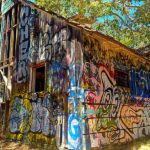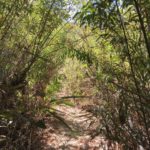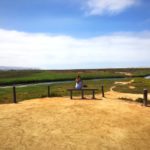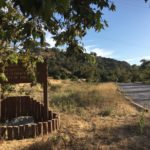Looking for a hike with incredible views of the Pacific Ocean and leads to the ruins of an abandoned home in the middle of essentially nowhere? Then the Rising Sun Trail to Solstice Canyon is the hike for you.

Situated in the Santa Monica Mountains, the hike down to Solstice Canyon leads to the “Tropical Terrace”, the ruins of a home built in the 1950s that was destroyed by a fire in 1982. Despite being hundreds of feet away from the usually-crowded Malibu beaches, the canyon feels a world away. The stone courtyard, garden terraces, stairways, and exotic tropical plants still remain. Near the ruins is also a small waterfall, Solstice Canyon Falls, cascading over sandstone rocks. With the recent drought, this waterfall is less than impressive but still worth checking out while you are in the area.

The Rising Sun Trail climbs northerly up the canyonside and provides breathtaking views of the Pacific Ocean. After descending into the canyon, the trail connects to the northern end of the Solstice Canyon Trail near the burned remains of Roberts family home. The hike back along the Solstice Canyon Trail is short and sweet, yet takes you past yet another abandoned structure—a stone cottage that has also fallen victim to fires over the years.

To get to the Rising Sun Trail from the main parking lot, walk west on Solstice Canyon Trail (paved at this point) about 0.1 miles and immediately turn up the TRW Trail on your right. Take the trail up to the former TRW site and the beginning of the Rising Sun Trail will be on the north side of the area. The climb up the Rising Sun Trail is an uphill battle, steadily gaining about 500 feet in the first mile before topping out around 760 feet. It’s easy to forget you are climbing that quickly in elevation with the views of the Pacific Ocean shimmering in the distance.


After 1.8-miles along a well-maintained and wide trail, you will drop down a series of switchbacks into Solstice Canyon, shaded by oaks, sycamores, and palm trees, planted near the Roberts’ family home. Descending down you will clearly be able to see the Roberts’ home with each switchback you pass, the brick chimney peeking out will be your first indication.

First you’ll reach the stream, with the waterfall nearby. Climb up a few ruined steps to reach the waterfall. The waterfall was nearly dried up even after a large rain storm and wasn’t that impressive at the time of this post. There were plenty of boulders to scramble along nearby to add a little bit more adventure into your experience.

After viewing the waterfall, return to the Tropical Forest to explore the ruins. Despite the fire, the ruins are fairly well preserved: with several walls and chimneys still standing.


After you’ve had your fair share of exploring, head south of the ruins. Here there will be a junction for the Deer Valley Loop Trail. This trail will add on some extra mileage (1.3 miles roundtrip to be exact) to your journey and was only recently completed. If hiking more isn’t on your itinerary, continue forward on the Solstice Canyon Trail. Here you will come across yet another abandoned structure, this one an old hunting cottage.

On your way back to the parking lot, the Solstice Canyon Trail switches from pavement to dirt road several times, hugging the banks of the Solstice Canyon Creek. This stretch of trail is flat, and easy to traverse.

History
Around 1865, Matthew Keller built a stone cottage, which you can still view from the Solstice Canyon Trail, although the cottage is fenced off. The cottage is believed to be the oldest existing stone building in Malibu.
In 1952, Fred and Pearl Roberts bought land in Solstice Canyon and had renowned architect Paul R. Williams design their home. The house was built of stone and wood, among a tropical area of waterfalls, springs, and trees. Fred never had the opportunity to live in his dream home unfortunately, dying from injuries sustained in an automobile accident before he and Pearl could move into the home Williams designed for them. The house was famous for its blend of natural features within the design, including the creeks, trees, and waterfall nearby.
Solstice Canyon is now a public park managed by the National Park Service. The Roberts’ home burned in 1982.

Solstice Canyon Tips
Tip #1: Parking is limited in Solstice Canyon. If the 30-40 spot parking lot is full, try to find a spot uphill off Corral Canyon Road outside the park entrance.
Tip #2: Bring sunscreen and plenty of water. Much of the Rising Sun Trail is unshaded and you will be exposed to the sun.
Tip #3: For those with children or simply just wanting to see the ruins and not hike, simply follow the paved path at the park’s entrance which will take you directly to the ruins of the home.
Tip #4: Dogs are permitted at Solstice Canyon as long as they are leashed. Park rangers have given out tickets for failing to comply.
Tip #5: This is a very crowded trail, especially on the weekends. If you are looking for solace, arrive early in the morning or visit on a week day.
Tip #6: Just past the house, keep an eye out for the Sosotomo Trail on the right. This trail ascends above the canyon on the west side and passes a few more ruined buildings along the way.

Elevation Gain : 760 Feet
Difficulty : Moderate
Total Distance: 3.2 miles
Trailhead address: 3455 Solstice Canyon Road, Malibu, CA 90265

Driving Directions: From I-405 N take Highway 1 for 15.5 miles. On Pacific Coast Hwy, turn right on Corral Canyon Rd. Drive 0.25 mile to park entrance on left.








